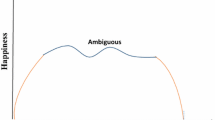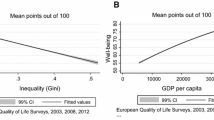Abstract
This paper examines the effects of happiness on income and income inequality. We postulate that happiness impacts upon the income generating capacity of individuals directly by stimulating work efficiency, and indirectly by affecting their allocation of time for paid work. These direct and indirect effects of happiness on income are tested in a regression model and the implication of these effects for income distribution is explored using an inequality decomposition framework. An empirical exercise based on Australian HILDA panel survey data (2001–2014) reveals that happiness has a positive and significant effect on income generation and contributes to the reduction of inequality.
Similar content being viewed by others
Availability of data and material
HILDA survey data are used which are owned by Melbourne Institute, Melbourne, Australia. I do not have authority to pass on these data to anyone.
Code availability
No codes are available. I have used standard regressions methods and some calculations using Xls.
Notes
This regression-based inequality decomposition approach is not new. Paul and Dasgupta (1989) were the first to use this approach to examine the contribution of inheritance to wealth inequality in Punjab, India. Morduch and Sicular (2002) applied this approach to account for income inequality in rural China.
In the literature, the word ‘happiness’ is used, even though the data are on ‘life satisfaction’. Within economics, the two are often conflated but in other disciplines and in the wider world there is a broader feeling that happiness is a short-run concept and life satisfaction is both broader and longer-run. Subjective well-being is another term used to refer to happiness in the literature (De Neve and Oswald, 2012). In this paper, we use the terms happiness and life satisfaction interchangeably to avoid any confusion.
The age-income hump can be represented by regressing log income of age and age2, happiness and other variables. In that case, one can examine the effects of these regression variables on the inequality of log income. This is not of our interest. We are interested in examining how different variables affect the inequality of income. Hence the reason for using Y rather than log Y in Eq. (1).
These variables are explained in Sect. 3.
For the benefit of readers, details on Hausman and Taylor (1981) instrumental variable method (HT) are provided in “Appendix B”.
Morduch and Sicular (2002) call this the property of equal additions.
The observed difference in elasticity estimates could also have arisen due to differences in the definition of happiness and methodology used. In the Russian study, happiness is measured on a scale from 1 to 5, whereas a scale from 1 to 10 is used in Australia. This suggests that the income elasticity of a 1-point increase in happiness in Australia should be compared with the income elasticity of a 4/10-point increase in happiness in Russia, which turns out to be = 3.0 × 4/10 = 1.2. This is still higher than the one obtained for Australia. To check whether methodology matters, the Graham et al. (2004) approach is applied to our data set. That is, we first regressed happiness on income and all other conventional variables using the 2001 data and obtained estimates of residual happiness. Then, we regressed income in 2005 on the 2001 residual happiness and all other variables used in model (3). The coefficient of residual happiness turned out to be 195.415 and statistically significant at 8 per cent. This provided us an income elasticity of 0.72 with respect to a 1-point increase in residual income. This estimate is still lower that the one observed for Russia (1.2) based on a comparable happiness scale. This reconfirms our belief that in an unstable context, happiness matters more than in a very stable context like Australia.
Most of happiness literature has concentrated on estimating happiness as a function of income and some control variables, the elasticity of happiness with respect to income obtained therein could be biased since income is not treated as endogenous.
This route could not be explored here due to non-availability of data on individual traits.
References
Currie, J., & Madrian, B. C. (1999). Health, health insurance and the labor market. In O. Ashenfelter & D. Card (Eds.), Handbook of Labor Economics (Vol. 3, pp. 3309–3416). Elsevier.
Dasgupta, P. (1997). Nutritional status, the capacity for work and poverty traps. Journal of Econometrics, 77(1), 5–37.
De Neve, J., & Oswald, A. (2012). Estimating the influence of life satisfaction and positive affect on later income using sibling fixed effects. Proceedings of the National Academy of Sciences of the USA, 109(49), 19953–19959.
Easterlin, R. (1995). Will raising the incomes of all increase the happiness of all? Journal of Economic Behavior and Organization, 27(1), 35–47.
Ettner, S. L., Frank, R. G., & Kessler, R. C. (1997). The impact of psychiatric disorders on labor market outcomes. Industrial and Labor Relations Review, 51(1), 64–81.
Frijters, P., Haiskien-De-New, J., & Shields, M. (2004). Money does matter! Evidence from increasing real incomes and life satisfaction in East Germany following reunification. American Economic Review, 94, 730–740.
Graham, C. (2010). Happiness around the world: The paradox of happy peasants and miserable millionaires. Oxford University Press.
Graham, C., Eggers, A., & Sukhtankar, S. (2004). Does happiness pay? An exploration based on panel data from Russia. Journal of Economic Behaviour and Organization, 55, 319–342.
Harold, S. L. (1975). The impact of poor health on earnings. The Review of Economics and Statistics, 57(1), 43–57.
Hausman, J. A., & Taylor, W. E. (1981). Panel data and unobservable individual effects. Econometrica, 49, 1377–1398.
Ifcher, J., & Zarghamee, H. (2011). Happiness and time preference: The effect of positive affect in a random-assignment experiment. American Economic Review, 101, 3109–3129.
Isen, A. M. (2008). Some ways in which positive affect influences decision making and problem-solving. In: M. Lewis, J. M. Haviland-Jones, L. Feldman Barrett (Eds.), Handbook of Emotions (pp. 548–73). The Guilford Press, New York.
Kenny, C. (1999). Does growth cause happiness, or does happiness cause growth. Kyklos, 52, 3–26.
King, M. A., & Dicks-Mireaus, L. D. L. (1982). Assets holdings and the life-cycle. Economic Journal, 92, 247–267.
Leibenstein, H. (1957). Economic backwardness and economic growth: Studies in the theory of economic development. Wiley.
Morduch, J., & Sicular, T. (2002). Rethinking inequality decomposition, with evidence from rural China. Economic Journal, 112(476), 93–106.
Murphy, K. M., & Welch, F. (1992). The structure of wages. Quarterly Journal of Economics, 107, 285–326.
Paul, S. (2004). Income sources effects on inequality. Journal of Development Economics, 73, 435–451.
Paul, S., & Dasgupta, A. K. (1989). Inheritance and wealth inequality: The case of the Punjab. Journal of Development Economics, 30, 301–324.
Paul, S., & Guilbert, D. (2013). Income-happiness paradox in Australia: Testing the theories of adaptations and social comparisons. Economic Modelling, 30, 900–910.
Schultz, T. P., & Tansel, A. (1997). Wage and labor supply effects of illness in cote d’Ivoire and Ghana. Journal of Development Economics, 53(2), 251–286.
Shorrocks, A. F. (1982). Inequality decomposition by factor components. Econometrica, 50, 193–211.
Stevenson, B., & Wolfers, J. (2008). Economic growth and subjective well-being: Reassessing the easterlin paradox. Brookings Papers on Economic Activity, 1, 1–88.
Strauss, J., & Thomas, D. (1998). Health, nutrition and economic development. Journal of Economic Literature, 36, 766–817.
Watson, N., & Wooden, M. (2012). The HILDA survey: A case study in the design and development of a successful household panel study. Longitudinal and Life Course Studies, 3(3), 369–381.
Watson, N., & Wooden, M. (2014). Re-engaging with survey non-respondents: Evidence from three household panels. Journal of the Royal Statistical Society: Series A, 177, 499–522.
Weil, D. N. (2007). Accounting for the effect of health on economic growth. The Quarterly Journal of Economics, 122(13), 1265–1306.
Acknowledgements
I am thankful to Carol Graham, Andrew Oswald, Sriram Shankar, Daniel Guilbert, and two anonymous referees for comments and suggestions on earlier drafts of this paper. This paper uses unit record data from the Household, Income, and Labour Dynamics in Australia (HILDA) Survey. The HILDA Project was initiated and is funded by the Australian Government Department of Families, Housing, Community Services, and Indigenous Affairs (FaHCSIA) and is managed by the Melbourne Institute of Applied Economic and Social Research (Melbourne Institute). The findings and views reported in this paper, however, are mine and should not be attributed to either FaHCSIA or the Melbourne Institute.
Funding
Not funded by any agency.
Author information
Authors and Affiliations
Corresponding author
Ethics declarations
Conflict of interest
The author declare that they have no conflict of interest.
Ethical approval
Not required. This paper used the HILDA survey data collected by Melbourne institute, Australia. These data are widely used by researchers.
Consent to participate
Not required. This paper the HILDA survey data collected by Melbourne institute, Australia.
Consent for publication
I am the sole author. No consent is needed.
Additional information
Publisher's Note
Springer Nature remains neutral with regard to jurisdictional claims in published maps and institutional affiliations.
Appendices
Appendix A
Appendix B: Details on Hausman and Taylor (1981) Instrumental Variable Estimation Method (HT)
The Hausman and Taylor estimation not only overcomes the problem of endogeneity but also accounts for the unobserved heterogeneity (\(s_{i}\)). All the instruments used in the HT estimation are taken from within the model. All the time-varying exogenous variables deviated from their individual temporal means serve as instruments and similarly all the time-varying endogenous variables deviated from their individual temporal means serve as instruments. For example, (Hit – Hi) serves as an instrument for Hit, where Hi is the temporal mean. All other instruments are constructed in the same way. Since there is no time-invariant endogenous variable in the model, no other instruments were required. All the instruments used are quite strong as they exhibit sufficient within-panel variation (see Appendix Table 9 below).
Once the instruments are specified, the xthtaylor command in STATA provides the HT estimates of Eq. (3) presented in the text. For the benefit of readers, we briefly outline the intermediates steps involved in the HT estimation. In step 1, the within estimator is used to obtain coefficients of time-varying exogenous and endogenous variables. Using these estimated coefficients, within residuals are obtained. In step 2, the within residuals are regressed on time-invariant exogenous variable, Female. In step 3, the variance components, \(\sigma_{\varepsilon }^{2}\) and \(\sigma_{s}^{2}\), are calculated using the residuals from the above two regressions (steps 1 and 2). These variance components are then combined to form weights. In step 4, Eq. (3) is transformed by multiplying the variables with these weights. The 2SLS is applied to this transformed equation using the set of instruments described in the text. This gives us the HT estimates which are consistent and efficient. For details, see Hausman and Taylor (1981).
Rights and permissions
About this article
Cite this article
Paul, S. Effects of Happiness on Income and Income Inequality. J Happiness Stud 23, 1021–1041 (2022). https://doi.org/10.1007/s10902-021-00439-5
Accepted:
Published:
Issue Date:
DOI: https://doi.org/10.1007/s10902-021-00439-5




